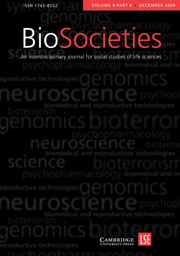Crossref Citations
This article has been cited by the following publications. This list is generated based on data provided by Crossref.
Epele, María
2011.
Emergencies and rescues: The logics of vulnerability and care among drug users in Buenos Aires, Argentina.
Addiction Research & Theory,
Vol. 19,
Issue. 2,
p.
161.
2012.
Improvising Medicine.
p.
119.
2012.
Improvising Medicine.
p.
1.
2012.
Improvising Medicine.
p.
205.
Epele, María
2012.
Sobre o cuidado de outros em contextos de pobreza, uso de drogas e marginalização.
Mana,
Vol. 18,
Issue. 2,
p.
247.
2012.
Improvising Medicine.
p.
174.
2012.
Improvising Medicine.
p.
152.
2012.
Improvising Medicine.
p.
29.
2012.
Improvising Medicine.
p.
52.
2012.
Improvising Medicine.
p.
85.
2012.
Improvising Medicine.
p.
183.
2012.
Improvising Medicine.
p.
93.
Petryna, Adriana
2013.
The Right of Recovery.
Current Anthropology,
Vol. 54,
Issue. S7,
p.
S67.
Sadler, Euan
and
McKevitt, Christopher
2013.
‘Expert carers’: An emergent normative model of the caregiver.
Social Theory & Health,
Vol. 11,
Issue. 1,
p.
40.
Kalofonos, Ippolytos
2014.
‘All they do is pray’: Community labour and the narrowing of ‘care’ during Mozambique's HIV scale-up.
Global Public Health,
Vol. 9,
Issue. 1-2,
p.
7.
Womack, Jennifer L.
Lilja, Margareta
and
Isaksson, Gunilla
2017.
Crossing a Line: A narrative of risk-taking by older women serving as caregivers.
Journal of Aging Studies,
Vol. 41,
Issue. ,
p.
60.
Pentecost, Michelle
Gerber, Berna
Wainwright, Megan
and
Cousins, Thomas
2018.
Critical orientations for humanising health sciences education in South Africa.
Medical Humanities,
Vol. 44,
Issue. 4,
p.
221.
Epele, María Esther
2018.
Neoliberal Care: Intimacy, Romance, and Drug Use in Argentine Dispossessed Populations.
The Journal of Latin American and Caribbean Anthropology,
Vol. 23,
Issue. 1,
p.
152.
Karlin, Jennifer
and
Hodge, Caroline C.
2022.
Intimacy, Anonymity, and “Care with Nothing in the Way” on an Abortion Hotline.
Culture, Medicine, and Psychiatry,


